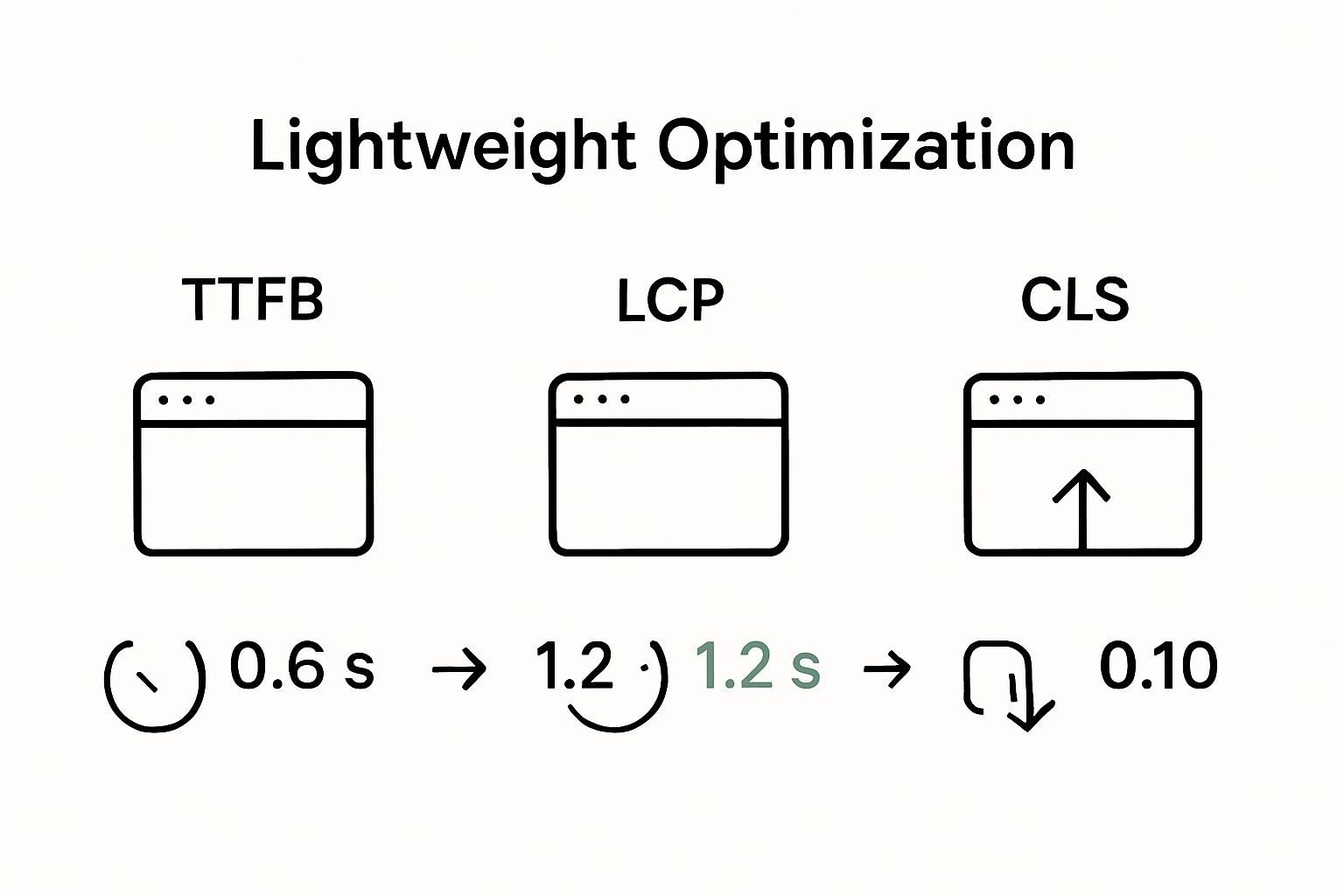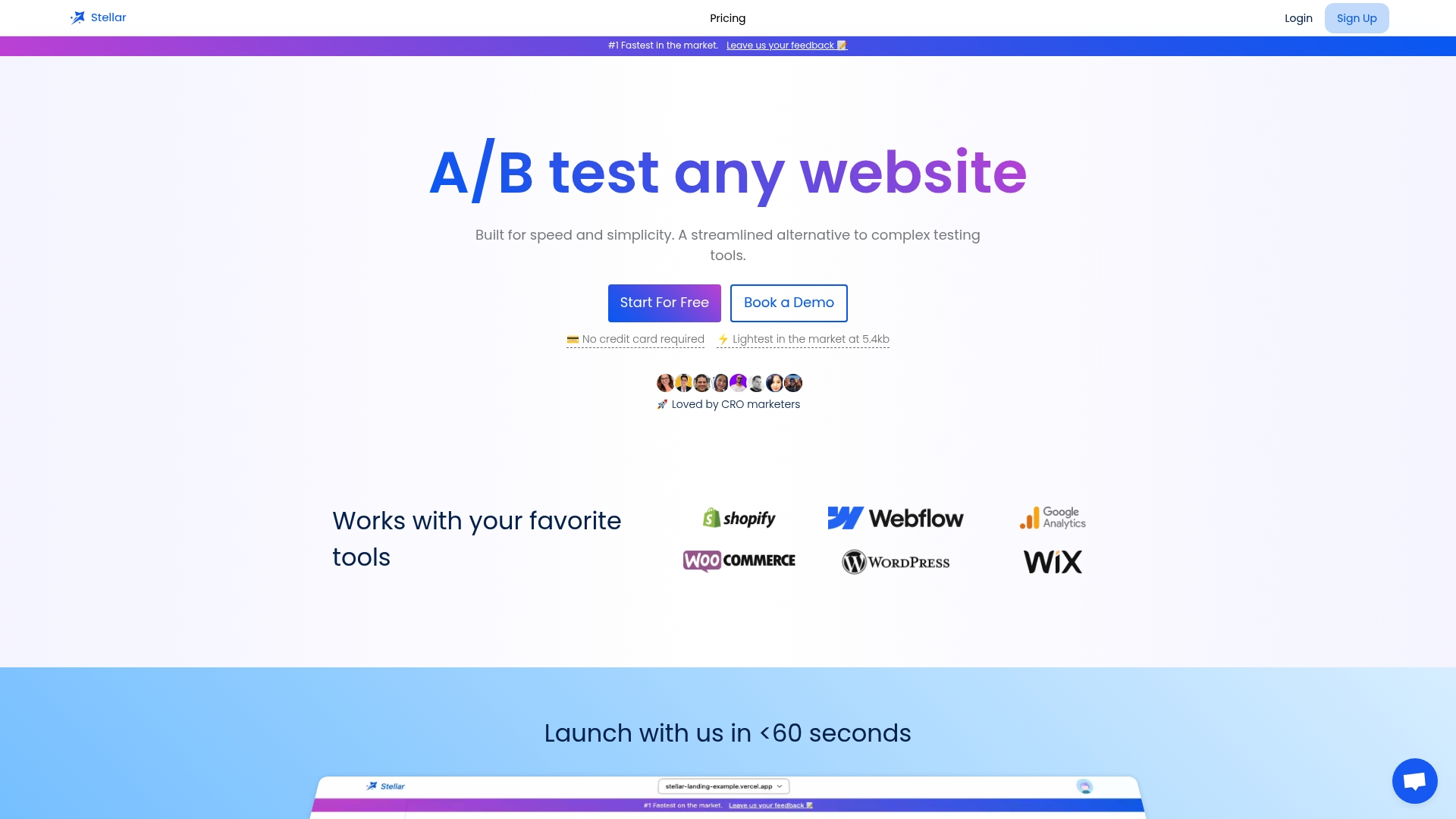
Understanding Lightweight Website Optimization for Better Performance

Websites now compete for attention in fractions of a second and every extra second of load time can silently destroy growth. A single second delay can drop conversion rates by up to 20 percent. Most people think faster sites just mean happier users but lightweight website optimization does much more. It cuts costs, helps the environment, and gives your business an advantage that traditional speed tricks cannot match.
Table of Contents
- Defining Lightweight Website Optimization And Its Importance
- The Impact Of Website Performance On User Engagement
- Core Principles Of Lightweight Website Optimization Techniques
- Measuring The Effectiveness Of Lightweight Optimization Strategies
Quick Summary
| Takeaway | Explanation |
|---|---|
| Lightweight optimization enhances website performance | It minimizes resource usage and improves overall efficiency beyond just speed. |
| Key principles include efficient coding practices | Focus on reducing file sizes, server response times, and optimizing caching mechanisms. |
| Faster websites boost user engagement and trust | A delay in loading can significantly decrease user satisfaction and increase bounce rates. |
| Measure performance through various metrics | Use indicators like Time to First Byte and Largest Contentful Paint to assess optimization success. |
| Consider holistic strategies for continuous improvement | Balance technical efficiency with user experience to create responsive and efficient web applications. |
Defining Lightweight Website Optimization and Its Importance
Lightweight website optimization represents a strategic approach to enhancing website performance by minimizing resource consumption and maximizing efficiency. Unlike traditional optimization methods that focus solely on speed, this technique addresses comprehensive performance improvements through intelligent design and technical refinement.
The Core Principles of Lightweight Optimization
Lightweight website optimization centers on reducing unnecessary computational overhead while maintaining robust functionality. By carefully selecting and implementing efficient technologies, developers can create websites that load quickly, consume minimal resources, and deliver exceptional user experiences. Explore our guide on website performance impact to understand the broader context of performance optimization.
Key characteristics of lightweight optimization include:
- Minimizing script and stylesheet sizes
- Reducing server response times
- Implementing efficient caching mechanisms
- Prioritizing critical rendering paths
The fundamental goal is creating web experiences that feel instantaneous and seamless, regardless of device capabilities or network conditions. This approach goes beyond traditional performance metrics by considering holistic user interaction and system resource management.
The following table breaks down the key principles and characteristics of lightweight website optimization, helping readers quickly compare focus areas and practical benefits discussed in the article.
| Principle/Characteristic | Focus Area | Benefit |
|---|---|---|
| Minimizing script and stylesheet sizes | Code efficiency | Faster load times, reduced bandwidth usage |
| Reducing server response times | Backend performance | Improved responsiveness, lower hosting costs |
| Efficient caching mechanisms | Resource management | Smooth repeat visits, less server strain |
| Prioritizing critical rendering paths | Front-end optimization | Content displays faster for better user experience |
| Modular code design | Architecture | Easier updates and less technical overhead |
| Minimal dependency integration | Dependency management | Avoids performance loss from unnecessary libraries |
Why Lightweight Optimization Matters
In an increasingly competitive digital landscape, website performance directly impacts user engagement, conversion rates, and overall business success. According to Google's Web Vitals research, websites that load within 2.5 seconds experience significantly higher user retention and satisfaction rates.
By embracing lightweight optimization strategies, businesses can achieve multiple critical objectives:
- Improved search engine rankings
- Enhanced mobile user experience
- Reduced hosting and bandwidth costs
- Lower carbon footprint through efficient computing
Ultimately, lightweight website optimization is not just a technical consideration but a strategic approach to creating digital experiences that are fast, efficient, and user-centric.
The Impact of Website Performance on User Engagement
Website performance is not merely a technical metric but a critical factor that directly influences user behavior, engagement, and business success. In the digital landscape, every millisecond of load time can significantly transform user interactions and conversion potential.
Understanding Performance Engagement Correlation
Users have increasingly shorter attention spans and higher expectations for digital experiences. Learn more about page speed optimization strategies to understand how performance impacts user perception. According to Google's web performance research, a delay of just one second in mobile load times can decrease conversion rates by up to 20%, highlighting the direct relationship between website speed and user engagement.
Key performance metrics that influence user engagement include:
- Page load time
- Time to first meaningful paint
- Interactive responsiveness
- Server response speed
These metrics collectively determine how quickly and smoothly users can access and interact with website content. Websites that load rapidly create positive first impressions, reduce bounce rates, and encourage deeper user exploration.
Psychological Impact of Website Performance
Performance is more than technical efficiency it represents a brand's commitment to user experience. Slow websites signal unreliability and can trigger user frustration, leading to immediate abandonment. Research demonstrates that users form opinions about website credibility within milliseconds of interaction, with loading speed being a primary factor.
The psychological implications of website performance are profound:
- Faster sites build user trust
- Quick interactions create positive emotional responses
- Smooth performance reduces cognitive load
- Responsive design enhances perceived professionalism
Businesses that prioritize website performance effectively communicate respect for user time and technological sophistication.
 By investing in lightweight optimization, organizations can transform technical infrastructure into a powerful engagement tool that attracts, retains, and converts users more effectively.
By investing in lightweight optimization, organizations can transform technical infrastructure into a powerful engagement tool that attracts, retains, and converts users more effectively.
Core Principles of Lightweight Website Optimization Techniques
Lightweight website optimization represents a sophisticated approach to digital performance engineering that transcends traditional speed enhancement methodologies. By strategically minimizing computational overhead and maximizing resource efficiency, developers can create web experiences that are both technically robust and user friendly.
Architectural Efficiency and Resource Management
Learn more about breaking performance barriers in modern web development. According to research from Web.dev, efficient websites require comprehensive architectural considerations that go beyond simple loading metrics.
Key architectural principles for lightweight optimization include:
- Modular code design
- Minimal dependency integration
- Intelligent resource allocation
- Dynamic content rendering
The fundamental goal is creating streamlined digital infrastructures that respond instantaneously while consuming minimal computational resources. This approach transforms website performance from a technical constraint into a strategic advantage.
Holistic Performance Strategy
Lightweight optimization is not merely about reducing file sizes but creating intelligent, adaptive web experiences. Developers must consider multiple interconnected factors that collectively influence website performance.
Critical components of a comprehensive optimization strategy encompass:
- Network protocol efficiency
- Browser rendering optimization
- Critical path prioritization
- Intelligent caching mechanisms
By adopting a holistic perspective, organizations can develop web solutions that are not just fast but fundamentally responsive to user needs. The optimization process becomes an ongoing dialogue between technological infrastructure and user experience, continuously adapting and improving.
Ultimately, lightweight website optimization represents a nuanced approach to digital design where technical excellence meets user-centric functionality. It transforms websites from static information repositories into dynamic, efficient platforms that anticipate and respond to user expectations with unprecedented precision.
Measuring the Effectiveness of Lightweight Optimization Strategies
Measuring lightweight optimization effectiveness requires a comprehensive approach that goes beyond traditional performance metrics. Successful evaluation demands nuanced analysis of technical performance, user experience, and business impact, transforming raw data into actionable strategic insights.
Performance Metrics and Analytical Frameworks
Explore lightweight A/B testing solutions to understand comparative performance evaluation. According to Google's web performance research, effective measurement involves multiple interconnected performance indicators that collectively reveal optimization strategy efficacy.
Critical performance metrics for lightweight optimization assessment include:

- Time to First Byte (TTFB)
- First Contentful Paint (FCP)
- Largest Contentful Paint (LCP)
- Cumulative Layout Shift (CLS)
- Total Blocking Time (TBT)
These metrics provide granular insights into website responsiveness, rendering efficiency, and overall user interaction quality. By systematically tracking these indicators, organizations can quantify the tangible benefits of optimization strategies.
Below is a table organizing core performance metrics mentioned in the article, along with their explanations, to clarify what each indicates when measuring lightweight website optimization effectiveness.
| Metric | Explanation |
|---|---|
| Time to First Byte (TTFB) | Time taken for the browser to receive the first byte of page data from the server. |
| First Contentful Paint (FCP) | Time until the first text or image is painted, indicating when content begins to appear. |
| Largest Contentful Paint (LCP) | Time until the largest visible element is rendered, reflecting perceived load speed. |
| Cumulative Layout Shift (CLS) | Measures visual stability by quantifying unexpected layout shifts during load. |
| Total Blocking Time (TBT) | Time when the main thread is blocked, affecting page responsiveness and interactivity. |
Holistic Impact Evaluation
Measuring optimization effectiveness transcends technical performance metrics. A comprehensive evaluation framework considers multiple dimensions of digital experience, including user engagement, conversion rates, and resource utilization.
Key evaluation considerations encompass:
- User experience quality
- Conversion rate improvements
- Computational resource efficiency
- Search engine ranking impacts
- Mobile and desktop performance variations
Successful lightweight optimization strategies demonstrate measurable improvements across these dimensions, transforming technical refinement into strategic business advantage. The goal is not merely faster websites but more efficient, responsive digital experiences that drive meaningful user interactions and organizational objectives.
Experience Lightweight Optimization in Action With Stellar
If you are striving for blazing-fast website performance and worry about the impact of heavy tools on your user experience, your concerns are justified. This article highlighted that even small delays can drive users away and sap conversions. Many traditional solutions fill your pages with code and slow things down, which goes against the very principles of lightweight optimization like efficient resource use and minimal site overhead.

Do not let your optimization tools become the bottleneck. Stellar redefines A/B testing with a script size of just 5.4KB, so you can track and improve your UX without sacrificing speed. Marketers and growth hackers at small and medium businesses use Stellar's no-code visual editor and dynamic goal tracking to experiment confidently while keeping their websites light and responsive. If you are ready to apply the principles of this article for a faster, more efficient website and see results right away, explore Stellar's solution today and start optimizing without compromise.
Frequently Asked Questions
What is lightweight website optimization?
Lightweight website optimization is a method for improving overall website performance by minimizing resource use while maximizing efficiency. To start, focus on reducing script sizes and improving server response times to enhance user experience.
How can I measure the effectiveness of lightweight website optimization?
You can measure effectiveness by tracking key performance metrics like Time to First Byte (TTFB) and Largest Contentful Paint (LCP). Regularly analyze these metrics to identify improvements and ensure your website loads faster, ideally aiming for reductions of 20-30% in these times.
What are some practical steps for implementing lightweight optimization?
Begin by minimizing the sizes of scripts and stylesheets and implementing efficient caching strategies. Prioritize key pages and gradually optimize them to ensure better performance and user engagement.
Why does lightweight optimization matter for my business?
Lightweight optimization enhances user engagement and can lead to higher conversion rates, as faster-loading websites better retain visitors. To capitalize on this, focus on the direct relationship between website speed and user satisfaction to drive business success.
What common pitfalls should I avoid during lightweight optimization?
Avoid excessive dependency on large frameworks or plugins that can add overhead. Instead, focus on modular code design and intelligent resource allocation to keep your website fast and responsive.
How long does it take to see improvements from lightweight optimization?
You can expect to see noticeable improvements within 30-60 days after implementing optimization strategies. Regular monitoring and adjustments are essential to maintain and enhance performance over time.
Recommended
Published: 10/11/2025